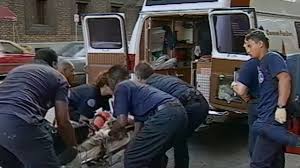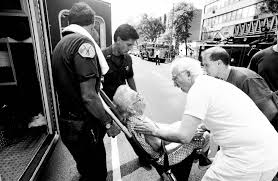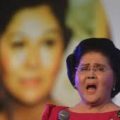
With recent heat waves, this documentary could not be more relevant. It details how Socio-economic differences in segregated Chicago also contributed to over 700 heat-related deaths in 1995.
Judith Helfand is already a Peabody Award-winning filmmaker. Here, she methodically analyzes why the poor and elderly living in the South and West Sides of Chicago were affected more than those in any other part of the city. Sparked by Eric Klinenberg’s book, Heat Wave: A Social Autopsy of Disaster in Chicago, published 7 years after the event, Helfand decided to investigate. To them, a natural disaster revealed an unnatural one that was man-made. As she says, cooked is a violent way to die.
Helfand is passionate and compassionate in her interviews exposing the contributing community problems, besides the heat, that caused this to become the deadly and devastating disaster for those most vulnerable in society.
The most striking images are of the 9 big refrigerated food trucks brought in by the city to stack the body bags as a makeshift morgue when the actual morgue ran out of space. Many of these people died alone and were never even identified. And the heartbreaking interviews of relatives of the dead who had to go through the trailers, body by body, to find their loved ones. It’s chilling.



Helfand does the narrative and interviews herself, digging into the problems of urban segregation, extreme weather, the politics involved and showing the difference between a natural and a man-made disaster caused by poverty and unpreparedness. She shows Mayor Richard M. Daley holding a news conference in the beginning of the disaster basically laughing it off as “We go to extremes in Chicago. And that’s why people love Chicago. We go to extremes.” Of course, as the number of dead bodies piled up, the Mayor took the situation much more seriously.
She has people speak for themselves which shows how the sick and elderly living in apartments without air conditioning who had nailed windows shut, because they were afraid of people breaking in to rob or hurt them, was a factor. For many, it was a matter of stay cool or stay safe. She graphically demonstrates the difference between the poorer neighborhoods on the South and West sides with boarded up homes and empty lots where banks would raise the rent, evict families and then flip the houses, selling them for more money, many times without making any improvements. She shows how dramatically different most communities on the North and Northwest sides look dramatically different.
She also interviews Steve Whitman, the chief of Epidemiology for the City of Chicago who shows graphically with color-coded maps, how lack of services in those neighborhoods, contributes to unhealthy living in those areas. There is higher incidence of everything from diabetes and breast cancer, to unemployment, access to guns, school closings, vacant lots and more. It all shows in statistics of lower life expectancy for people who live in those areas than in more middle class and affluent parts of the city. There was no heat emergency plan, but he said what they really needed was a poverty emergency plan. When asked if the city was addressing it, he said with a smile, “Don’t be ridiculous.”
Interesting that Whitman left his job with the city to create Mt. Sinai Hospital’s Urban Health Institute to try to deal with the health disparity gap caused by poverty in those particular zip codes.
Helfand also shows government exercises that were funded after the disaster to the tune of hundreds of thousands of dollars staged in a very poor neighborhood. That money could have been used to provide the services that area needed to rise above the poverty level. Seeing a food truck providing healthy groceries in a low income area or a young African-American boy try an apple for the first time in his life makes an impact. It’s a scene filled with discovery and joy.



I remember that weekend working as Associate Producer of the City of Chicago’s Magic City Festival, whose honorary Chairperson was Maggie Daley. It was a massive children’s performing arts festival on Navy Pier. Keeping kids in 105 acts from all over the city safe and hydrated that weekend was a major task as we kept hearing reports of people dying from the heat.
Everyone, including all levels of government, should see this film, especially the leaders of our urban centers. As global warming becomes more of an issue and hopefully, more accepted as one to be dealt with, the lessons learned from that 1995 heat wave in Chicago should be a guideline for the future. See this very well-documented film that gives viable suggestions for what can be done to dodge another disaster. No one should be cooked simply because of their zip code.
Kartemquin Films 76 minutes Documentary
Check your local listings.
Now playing at the Gene Siskel Film Center in downtown Chicago with screenings followed by panels of city and public health officials, experts and activists, including author Eric Klinenfeld and Helfand herself. Details at https://www.cookedthefilm.com/siskel




